The addition of keys on wind instruments is a practice that has a long historical tradition and its variables are almost countless.
My post will deal with just one key: the one that covers the bell hole (BH) of a recorder.
In recorder original repertoire the call for the use of BH closing is scarce but not absent. We have to bear in mind that most of our original (declared) repertoire was meant for amateur players. As it will a painful job to try to historically justify the need for covering the BH let us assume that we want to use our instruments at its fullest capacities and that implies the topping of any hole in order to produce a sound that is otherwise impossible to obtain, i.e the topping of the BH.
Is such key necessary? It is to play those notes that need the BH covered. This might sound a bit obvious but it is not. Many people, including myself, use the leg to top the BH in order to play one of this notes, for example a high F# on an alto recorder. This is an extremely awkward movement and its drawbacks are obvious. Let it suffice to remember how ridiculous the whole thing looks when the adventure fails and we get a wrong and loud shrieking tone (and that Kung fu look if we are playing in a standing position). And obviously there is no way to use the leg when playing a large instrument.
Now I would like to draw the attention to the existence of several new non historical models of recorders designed to make a better performance in 2 main aspects:
Dynamics & Range
Some of these models are: Eagle, Helder, Strathmann, Ehlert by Moeck, Modern by Mollenhauer, etc.
I have tried some of these myself and both dynamics and range can be controlled up to a certain extent. Dynamics are still in the realm of suggestion since the physics of a recorder embouchure is what it is and is not meant for a great flexibility on that area. Dynamics, if you want to have something similar to a saxophone or a violin and not the mere illusion of it, are only possible using amplification (I will discuss this sinful proposal in another post).
The range is the most interesting and tricky area. Most of these modern recorders claim to perform well on the third octave but the high register is full of complicated fingerings – as it is on any given recorder -. Susanne Fröhlich, an enthusiast of the Helder model, writes in her blog (bold italics within quotes are mine):
The third octave is played completely without closing the bottom hole – but of course you can still use fingerings with closed bottom hole (some of them work even better and are better in tune then. This is also the reason why Johannes Fischer did ask for a stopped foot joint with an extra bottom key at the side). Since many of the fingerings are based on harmonics and work with “shadowed” fingerings, many of these notes can be played softly.
This appear to be a further reason to use the HB key (or stopped foot joint). If, as Fröhlich comments, some tones in the third octave work better and are more in tune that is a no-brainer!
What I do not quite understand is Fröhlich’s observation about Helder’s sound unit properties – at the bottom of her post – when she states:
2.Adjust the height of the wind channel exit (not so useful).
I am sure both Helder and Mollenhauer gave a lot of thought when providing the instrument with a feature so distinctive and that will exert a dramatic change in the voicing. Stating that this is not so useful makes the whole post stumble.
On her latest post – Recorder bores and what they tell us – she writes: …we do have a third octave, even though this fact is still ignored by some recorder players today. As an example of this ignored third octave she points at the recorder map, a site that looks interesting at first sight but when you click on the menu General / Registers, it reads:
The minimum range is an octave and a sixth (medieval and early baroque models) and the maximum range is 2 octaves and a fifth (baroque models and modern instruments).
So it seems the team formed up by Ulrike Mayer-Spohn and Keitaro Takahashi have forgotten the existence of the bell hole but at the bottom you spot a little chart branded: covered register / foot-hole covered – with three obtainable tones and an explanatory note in bold type: It is not possible to make a fluent transition between the high registers as these registers do not overlap. Finally the page provides further info at this link: http://www.recordermap.com/contents/general/register_Newin.html
This is a chart of the whole range (?) of possible notes and a series of categorical statements that are completely biased and inaccurate apart from leaving out of range the last note of the Allemande of the Partita by J.S. Bach, that note is simply not possible according to the info provided.
We have some more serious works on recorder range and fingerings. Il flauto dolce ed acerbo by Michael Vetter with hundreds of different fingerings or the charts in Walter van Hauwe’s The Modern recorder player are just two examples (both in the Bibliography by Mayer-Spohn and Takahashi). But if a recorder player wants to discover this intricate fingering world the only way is to defy the Minotaur and enter the labyrinth of each recorder in particular.
But let’s go back to the real world with a practical example on a given instrument. My plastic Yamaha tenor YRT-304B fitted with a custom-made bell key designed by Daniel Bernaza can produce every note from C to c”’, that makes 3 complete chromatic octaves, to this add a very soft B when fingering low C# and the bell key depressed. Eagle fingerings have a range of two octaves and a sixth and Helder 3 octaves and one extra whole tone (this info I am quoting from their official sites). Here our baroque or renaissance recorder fitted with a proper BH key is on almost equal terms with the modern designs but there is something that me must not forget. Eagle, Helder, Ehlert, etc., are all new instruments and we have to learn to play them and they are not the Morgan Alto or the Musch Tenor or the Meyer Soprano you have. The BH key is something you attach to your baroque or renaissance instrument and you just have to learn to forget using your knee and start using your little left finger to depress the key.
As far as I know the first BH key was devised by Carl Dolmetsch. There are other models by Philippe Bolton and Peter Worrel.
These different photographs speak for themselves:
Dolmetsch
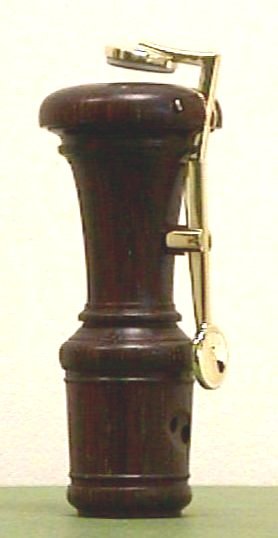
Bolton
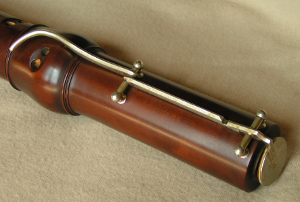
Bolton’s double bell key
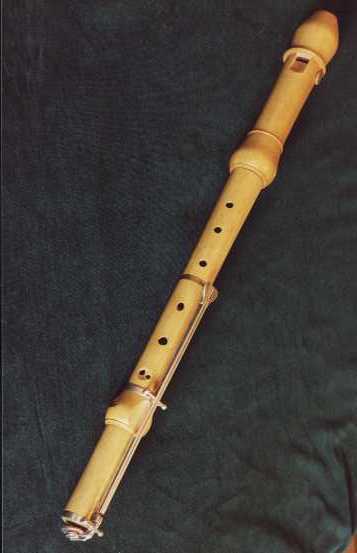
Worrel

All the above bell key systems are attached to the instrument by means of screws or pins. Both Dolmetsch’s and Bolton’s single bell keys are actioned using the lower little finger, an important disadvantage if you have to use it for another note. The key designed by Daniel Bernaza can be fixed and removed without leaving any trace on the instrument. You don’t want your Morgan Voice flute to be screwed in 🙂
Bernaza
Here we can see three different sizes of recorders each one fitted with a HB key using Scotch tape to adhere the two anchoring areas. This is something anyone could do (I actually did it). And, even more important, anyone can undo it.
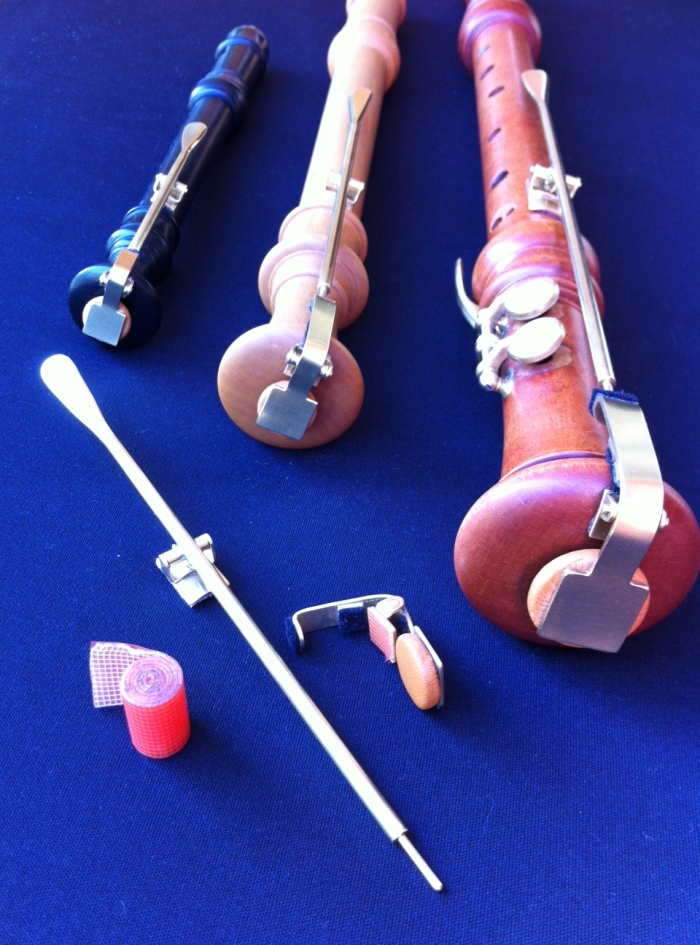
To customize the key there are some basic measurements to be made and the rest is solved by the maker. This is a nice and well known diagram Daniel Bernaza sent me over to get the right measurements:

A is the distance from your little finger to the bell end.
B is the diameter of the bell external body.
C is the diameter of the bell hole.
This is the latest and more advanced model and it can be dismantled without touching the fixation areas. That is specially handy with larger instruments such as a tenor or a bass in order to disassemble it for transport.
The following are some photos of Bernanza’s latest model bell key fixed on my Yamaha…
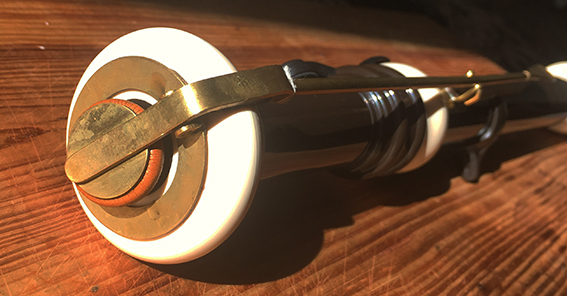
The anchoring area is now circular to improve stability.
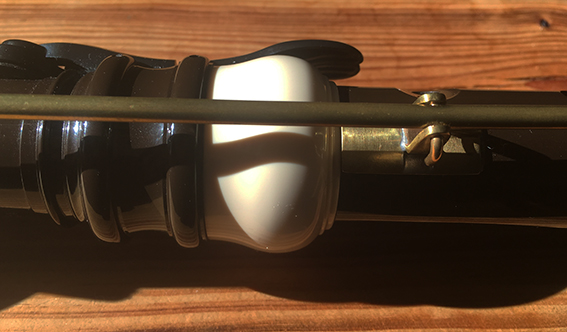
The removable pin allows to disassemble the key extension mechanism for better transportation. Leaving just the anchoring point and the bell topping mechanism attached.

The key has a “fine tuning” extension that allows for small changes both in the overall length and, most importantly, key angle for a customized finger contact.
I would like to have a more complete sound example to show the key capabilities but just have a little prelude by Bach played with the Yamaha tenor fitted with the key. Hope you enjoy it…
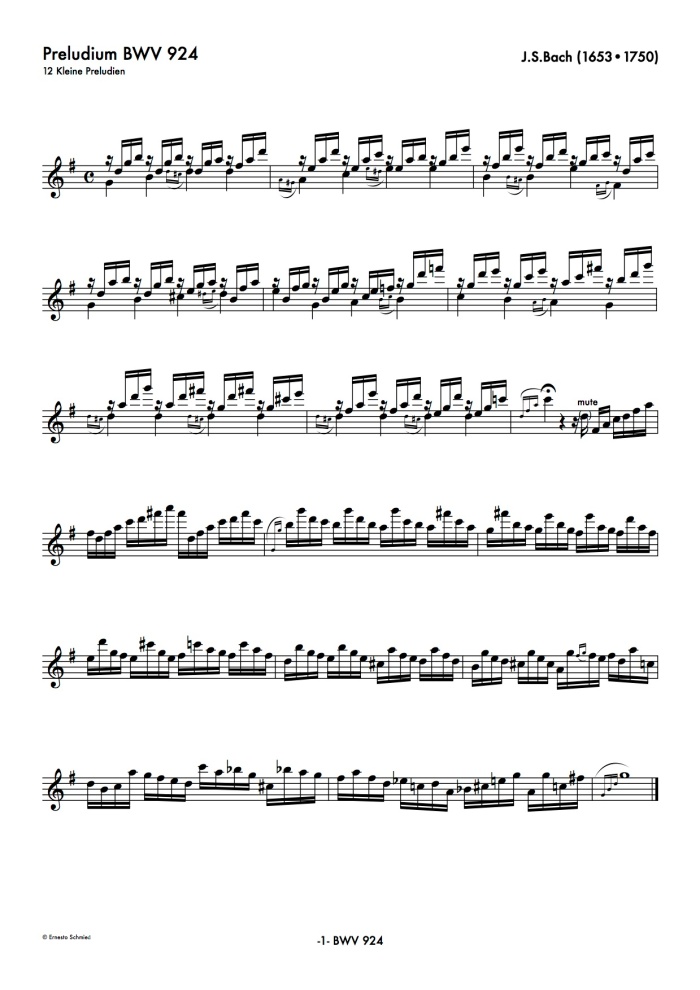
Hello Ernesto,
thank you for your thoughts. Regardig your text about my articles, I would like to add two things:
1.) Of course have I been in touch with Mollenhauer about the possibilities of the Sound Unit, so I would not write anything which would not make sense and which I haven’t completely explored.
2.) The reference to Ulrike is to show, that some professional (!) recorder players still do think that the recorder only has two octaves and a second. Ulrike e.g. did a granted (!) research on contemporary recorder techniques.
However, you might want to change your text again, or give me more feedback if you still don’t agree with what I write.
All the best
…Susanne
LikeLiked by 1 person
Hi Susanne, thanks for your feedback. I do not say you have given little thought to that particular function of the sound unit but stating that is not so useful is a rather vague and subjective observation. Usefulness is for each one to decide upon and if one is carrying a scientific research the aim is to present facts and usefulness is not exactly a fact. I am sure the Sound Unit adjustability was conceived to produce a distinctive whatever (I ignore the aim myself). I have just seen you have changed the text but maybe stating the original idea Helder / Mollenhauer had in mind will give us readers a better understanding.
As or the reference of the Recorder Map I might have misunderstood your presenting its content as en example of ignoring the existence of the third octave. From the reading it seems that the team formed up by Ulrike Meyer-Spohn and Keitaro Takahashi are providing the right info, again, sorry if I misinterpreted your writing. It would be much more clear if you point out the deficiencies of their information. I will change the text of my wrong reading of your opinion ASAP.
Last but not least I do think that a bit of controversy in our small world is an important and healthy “sport”. Nevertheless I must say your writings are most interesting and needed to feed the present status of recorder playing / thinking.
Thanks again and keep in touch 🙂
LikeLike
Thank you for discussing this topic! I have also enjoyed experimenting with bell keys, and at one point I also made one that could attach and detach without damage. I actually made two versions, one of which only closed the bore and the other which extended the bore of a Baroque alto to low E. I am certainly of the opinion that we should use every tool available, and bell keys are an often neglected way to get more possibilities from an existing instrument.
I am also a devotee of the Helder model (the tenor particularly – I’d love to have a bell key on mine!) and this is my take on the issue of the Sound Unit for what it is worth. I also find that the ability to “bite” the block to change its position while playing is not especially useful. However, the design which allows for that does offer other features which I find extremely useful. If anything, the ability to move the block with the lip or teeth is more of a side effect of those other features. The adjustability of the block via thumb screw is very useful (I use it to compensate for different voicings of different roof pieces, or to compensate a little when the roof I am using gets soggy, for example). The way it is positioned with the rubber spring (really a pad more than a spring) and the screw is quite simple and effective, and the fact that it could be mobile while playing is incidental.
In other words, I think the Sound Unit design is completely worthwhile; but being able to pinch the block while playing isn’t why.
LikeLiked by 1 person
Hi Emily, nice to hear from you and thanks for your clear description on the Sound Unit actual actioning. My question at this point is: what is that position change supossed to do? I think usefulness is a very personal consideration. But maybe the pinching of the block while playing causes nothing, I simply don’t know it.
As for your models of bell keys I would be more than thankful if you would share your designs with us!
Thanks again and look forward to hearing from you 🙂
LikeLike
Pinching the block does change the sound. But it is difficult to do, especially if the thumb screw position is such that the “spring tension” is tight and would require a lot of force. And the effect it produces is to soften the sound a bit, but also lower the pitch for a sort of “strangled” effect. I am sure there is some piece of music out there where I would want to make that effect, but I have not personally come across any instance where squeezing the block made a sound I wanted or was worth the trouble.
But as I said, the same sound unit design also has many other benefits that are extremely useful.
I will have to dig up my bell key – I haven’t used it since I got a Helder, actually! It is very rough and “home-grown” looking, but does get the job done. 🙂
LikeLiked by 1 person
Thanks for your feedback Emily! I am very curious about your bell key, maybe you could take some photos and send them over 🙂
LikeLike
Dear Emily, Dear Ernesto,
I think there is a misunderstanding: The lip-control is actually working very well on the Helder Tenor (especially in the nutrual position of the block) and it is – in my humble opinion – one of the big revolutions in performance practice of the recorder. Wait a few days and you can read more about it on my BLOG (https://susannefroehlichrecorder.wordpress.com/).
In the meantime you can watch following video:
The feature which is not so “useful”, is the adjustment of the windway exit. It makes the sound very airy and unflexible and it is very complicated to move the two screws. Of course it is impossible to change the position of the srews while performing. However, it is much easier and quicker to move the upper reed up and you almost get the same result.
Give it a try and let me know what you think. I am curious.
All the best
…Susanne
LikeLiked by 1 person
Susanne, Now I understand about which part is “not so useful”! I think the problem I have had with the lip control is that with experimenting with the exact position of the little rubber “spring” part and the block position, I find that I mostly play with the screw in a position that makes the block not able to move very much. So using the lip control would require biting quite hard. But at least I won’t do it by accident! 😉
I do agree that the little screws to raise the “south” end of the roof are not so useful, at least initially. But I think that is partly because Mollenhauer makes the roof pieces so that the roof is almost too high – so of course using the screws to raise it higher only makes the sound worse. I filed the “shoulder” parts of my roof pieces down a little, which lowers the roof height above the block, and that gives a little more useful adjustment range for those screws. But actually, what I have found to be easier to deal with and more flexible is to use small strips of paper or tape to experiment with the roof height instead of using the screws. It is more predictable, easier to see and control, and you can figure out what you want for each roof piece and then leave it that way instead of changing the screws around. Also, you can experiment with raising it only at the “north” end, only at the “south” end (and this makes a surprising amount of difference!), or at both ends together. I wouldn’t necessarily expect Mollenhauer to sell a product with instructions telling you to use tape to adjust it, but it does actually work very well.
LikeLiked by 2 people
Dear Ernesto, thank you for this interesting article.
My personal opinion is that for early (original!) recorder music no bell key is needed. There are plenty of original instruments in different sizes (f, g, a, b flat, c, d, etc.) to avoid high f sharps and higher notes with closing the bell. I believe that all the “strange” sizes were used more often than we think.
For contemporary music there should also be thought of historical performance practice. Why use an instrument with special features (like a bell key) for contemporary recorder music when the composer does not know that this is possible and therefore does not write for such an instrument? Using the Helder tenor recorder for playing Shinohara’s Fragmente is comparable to playing the Bach flute partita on Boehm flute. Let me be clear: everybody should do what he/she prefers but in my opinion we should respect the composition and the composer and if an instrument with a bell key is needed, a composer should write a piece for it. But if a composer wrote a piece for an instrument without a bell key but he wishes to avoid the trick with the knee, he/she should be asked.
I am happy that recorder makers still look for “improvements” for our instrument. But new instruments provide solutions for the future, not for the past.
Best wishes,
Sascha Mommertz
LikeLiked by 1 person
Hi Sascha, thanks for your time spent in reading my post and sending feedback over.
I completely agree with you when you say that the use of the bell key is not needed for early or modern original repertoire that was written for the recorder (without a fitted bell key). Its use is not to facilitate playing of the original playable repertoire.
What about transcriptions of any music written for a different instrument? Any music, be it from the Middle Ages or a recent work.
A lot of 19th century music written for transverse flute (oboe, clarinet, etc.) is playable on recorder providing the bell key is fitted. Our “official” original repertoire makes for a very small percentage of our actual repertoire.
Thanks again and best wishes to you too 🙂
LikeLike
Hi Ernesto, I’m interested in the detachable bell key by Bernanza. Does he produce them anymore? If so could you send me his contact?
LikeLiked by 1 person
As far as the bell-key not being “needed” for older repertory, I can’t agree. It suddenly opens up all of the baroque flute repertory, transposed, for one thing. There is so much music that can be transcribed like some of the violin sonatas of Bach and others, Bach’s organ trio sonatas can be turned into pieces for solo recorder and obligato keyboard, and so on. There is plenty of modern music that makes use of covered bell notes like Leenhouts’ Daido, which could be played standing with a lot of silly knee jumping, or the performer would be forced to sit and be very careful they are not wearing clothing that is too porous to allow for good stopping of the bell (I saw a woman once who performed a recital in which she decided to wear a loosely woven dress and none of her planned bell-covered notes worked). I have had quite a bit of experience playing with a bell because I have an instrument with a spare bell that has a key, an option not discussed in this article, and I found the key enormously useful not just for extending the range of the instrument, but for alternate fingerings, dynamic fingerings, trill fingerings, and other effects. You won’t see why it is useful until you’ve had one for a while and really made it part of your playing, not just an occasional trick. I spent some time studying with Daniel Waitzman many years ago and he completely altered his approach to the instrument based on the bell-key. He was really pushing makers to come up with something like the Helder, but in the 1960s and early 70s there was not a strong interest. His interest in a truly modern recorder made him an outcast in the height of historical interest, but he was a prophet of things to come and had described something like the Helder decades ago. The bell key is not the “future” of the recorder, but its utility is more than proven to me and it does its thing with no damage to the original sound of the instrument. It is a happy friend to the recorder as you already know and love it and I think more people will start using it.
LikeLiked by 1 person
Thank you David! I completely agree with you, there is not such a thing as “the future recorder”. The bell-key is just a key to open new possibilities, as you point out, for much more resources than just extending the range and, most importantly, using the instrument you desire, not necessarily a “modern” recorder. Thanks again David Dyer.
LikeLike
Some more thought if you don’t mind. I would love to know how you got a full three octaves from a tenor, what are your fingerings if you could share them?. I think I am in agreement with you about your assessment of the modern recorders. I studied with Daniel Waitzman, the foremost proponent of the bell key who had a Dolmetsch key put on his recorder in 1965 and never looked back. Your picture of a Dolmetch bell key is incorrect by the way. The Dometch model had posts and axels at both ends, not an axel cut into the finial as in his photo, that is by another more recent maker, and the spatula for the Dolmetsch model is a lot smaller. It is a more elegant and modern design, posts and axels are just superior, as Daniel’s mechanism would be. I will send a picture from the cover of Waitzman’s The Art of Playing the Recorder if I can which is really about the bell-keyed recorder. It is a book you should have, although the cover is not the same now, but it goes into the bell key in depth and gives many alternate fingerings with the bell key that are useful for color, dynamics, trill, register changes, etc. He used it as an integral part of his technique, not an adjunct. You can still get the book on amazon. Unfortunately, his health doesn’t allow him to travel anymore so he doesn’t perform, but I am trying to encourage him to make video content since that is all any of us can do these days anyway. There are few recorder players that can make the brag that they won honors as impressive as winning the Concert Guild Artists Award.
Well, I could not find out how to paste in the detailed photos I took of my book cover of Waitzman’s Dolmetsch bell key, but here is a link to an original edition copy being sold on eBay that gives you a good enough look to see the Dolmetsch system and how it differs from your picture. It is really a supreior design. I wish I cojuld somehow send a photo of the one my father and I made out of discarded clarinet keys that works great. It is a rotary system that has quicker action than any other and uses all posts and axels. I have never seen anyone attempt another system like it, it is unique as far as I know. If you can tell me how to send pictures I will do so.
https://www.ebay.com/i/303262013221?chn=ps&norover=1&mkevt=1&mkrid=711-117182-37290-0&mkcid=2&itemid=303262013221&targetid=1068400076350&device=c&mktype=pla&googleloc=9015099&poi=&campaignid=11613545184&mkgroupid=114145866638&rlsatarget=pla-1068400076350&abcId=9300455&merchantid=7867094&gclid=Cj0KCQiAlsv_BRDtARIsAHMGVSYALBju2DUPHgweebaScyGsR17Zq5i5k07UDqXJ4sku1zAErDezdBAaAgo_EALw_wcB
LikeLike
Sorry to chime in again! As to the need for finger 7 to need to cover another note and thus making finger seven a poor finger for the bell key, in practical use, if you know the fingerings, it just doesn’t come up. The only thing I could see as an issue is that the really best fingering for the high Eb is Ø1256 7/2 so that if you have to move from that to a bell-key note there is a jump from the hole to the bell key. Most people still use Ø12456 for Eb even though it’s not the best, and for quick passagework, it does fine going to a bell-keyed note because if you’re really moving that fast no one is going to notice the slight sharpness of Ø12456. Waitzman never came up with a fingering where you need to cover 7 and the bell. With my bell key, the key is actually close enough to the hole that if there were such a note I could cover 7 and BH if I wanted. It has never come up. I think I would always prefer the key for the right had because there is so much less exposed keywork exposed to get bent or damaged and the travel of the key is smaller, which I think is important for agility.
LikeLike